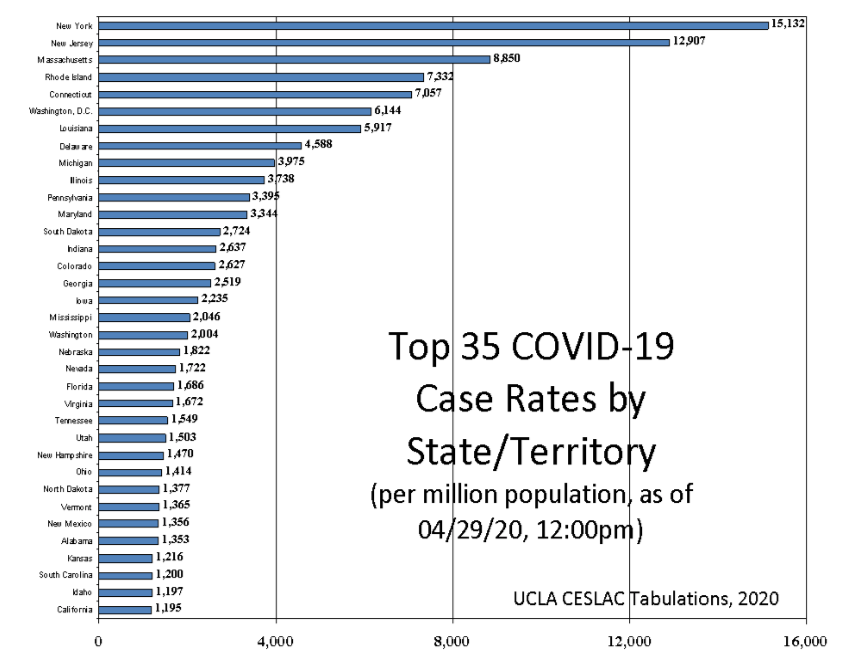By David E. Hayes-Bautista, Ph.D. and Paul Hsu, M.P.H., Ph.D. • UCLA Health Center for the Study of Latino Health and Culture
State and terrritorial governors have implemented pandemic protection measures in order to interrupt and slow down the passage of the coronavirus throughout each state’s population. Some of these measures are implemented at the individual level, such as wearing a facemask or maintaining social distance. The risk of transmission is much higher among crowds of people in close proximity, so another set of measures operates at the group level, trying to keep large groups from forming by keeping potential members dispersed.
“Romaine lettuce tainted with E. coli can be recalled or removed from grocery stores to prevent transmission,” said Paul Hsu, an epidemiologist at UCLA. “When someone is infected with coronavirus, we have to rearrange social contacts to interrupt that person-to-person transmission.” Crowds at sporting events, audiences at concerts, and students in classrooms have been dispersed by cancelling games, events, and classes.
Some states implemented pandemic protection measures early in the pandemic, others later. The implementation of these measures saved lives, but created educational, economic, and social dislocations. The question facing our governors is when to begin to relax the measures, and how much. Too much too soon could lead to another outbreak of COVID-19 cases and subsequent deaths, requiring another round of potentially disruptive protective measures.
“While every state is different, the coronavirus does not respect state boundaries,” said David E. Hayes-Bautista, Director of the Center for the Study of Latino Health and Culture at UCLA. “A comparison of COVID-19 case rates is a logical place to start for all governors when assessing what to do with their pandemic protection measures.”
Hayes-Bautista pointed out the wide range of case rates, from over 15,000 cases per million population in New York to 435 per million in Puerto Rico. “New York has around 35 times as many cases per million residents as Puerto Rico. This suggests that the respective governors may want to make different decisions about pandemic protection measures.” As another example, Michigan, with a case rate over three times higher than California’s, may want to consider a timetable different from that of the Pacific Coast state. Furthermore, depending on the progress of the flattening of the curve in those states, the relaxation of measures in one state could adversely affect the success of protection measures in a neighboring state.
Other factors besides the COVID-19 case rates—for example, hospitalization or death rates, testing availability, or health care capacity—may also influence the decision to implement, continue, or relax pandemic protection measures, but the comparative state and territory rates provide a starting place for the decision-making process, guided by basic public health precepts and based on uniform data.
About the Authors. David E. Hayes-Bautista, Ph.D., is Distinguished Professor of Medicine and Director of the Center for the Study of Latino Health and Culture at the David Geffen School of Medicine at UCLA. Paul Hsu, M.P.H., Ph.D., is Assistant Adjunct Professor of Epidemiology at the Fielding School of Public Health at UCLA.
About CESLAC. Since 1992, the Center for the Study of Latino Health and Culture (CESLAC) of the David Geffen School of Medicine at UCLA has provided cutting-edge, fact-based research, education, and public information about Latinos, their health, their history, and their roles in California society and economy.
For more information, or to arrange a telephone interview with the Center’s Director, David E. Hayes- Bautista, Ph.D., Distinguished Professor of Medicine, please contact Adriana Valdez, at (310) 794-0663 or cesla@ucla.edu
— Amigos805.com editor’s note — Please see the following related links:
- Uninsured Working Latinos and COVID-19: Essential Businesses at Risk
- Bilingual report: Agricultural Commissioner Issues Advisory for Agricultural Worker Protection During COVID-19 Crisis
- Mexican Consulate in Oxnard — 805 UndocuFund reactivated to help undocumented families in Ventura, Santa Barbara counties
- Bilingual report: Agricultural Essential Worker Cards Issued to Farmworkers
- Resources for Immigrants During Coronavirus/Recursos para inmigrantes durante Coronavirus

